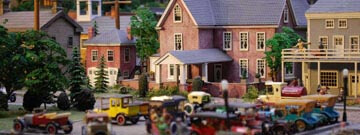
Fallingwater
Even then, a name seemingly coined on the spot as Frank Lloyd Wright hurried to finish his blueprints for the Kaufmann family-embodied the vision of a house that would revolutionize the world of architecture and become an iconic western Pennsylvania landmark.
At a time when Pittsburgh was a haven for industry and opportunity, Fallingwater reflected a blend of eccentricity, modernism, and courage. Edgar Kaufmann, Sr. was the owner of Kaufmann’s, one of the most profitable retail stores in the United States, and was regarded as a charismatic, respected, and business savvy gentleman. During the Great Depression, he played a role in New Deal public works programs. During that time, he met Frank Lloyd Wright and immediately was intrigued by his enlightened ideas and unorthodox tastes.
Edgar and Liliane, his wife, built a modest weekend house in 1921 at Bear Run. With its cascading waters and steep stone ledges, the Kaufmanns found the area to be ideal, the landscape beautiful, and Bear Run's falls majestic. During the next decade, the couple spent an increasing amount of time there. By 1933, they owned 1,914 acres and decided to build a more suitable home. Thus, Fallingwater was conceived.
The main house was constructed between 1936–1938, and a guest house was added in 1939. Some of the unusual attributes of Fallingwater are its terraces, which total 2,445 square feet; floating stairs that lead to pools; and even beams that were re-shaped to allow trees to stay where they were. Most notably, Fallingwater is built and protrudes over a 30-foot waterfall, where rushing waters and soothing sounds reflect the very essence of Fallingwater.
When Edgar, Sr. passed away in 1955, his son inherited the home and continued to use it as a mountain retreat until the early 1960s. Wanting to be sure it was preserved correctly, Edgar, jr. (the lowercase ‘j’ was his chosen distinction) entrusted Fallingwater to the Western Pennsylvania Conservancy.
Since 1964, more than four million visitors have seen the house, its alluring rooms, stunning views, and undeniable master craftsmanship. Fallingwater's historical significance and importance to the landscape of western Pennsylvania made it a perfect addition to the Miniature Railroad & Village®.
Fallingwater
Even then, a name seemingly coined on the spot as Frank Lloyd Wright hurried to finish his blueprints for the Kaufmann family-embodied the vision of a house that would revolutionize the world of architecture and become an iconic western Pennsylvania landmark.
At a time when Pittsburgh was a haven for industry and opportunity, Fallingwater reflected a blend of eccentricity, modernism, and courage. Edgar Kaufmann, Sr. was the owner of Kaufmann’s, one of the most profitable retail stores in the United States, and was regarded as a charismatic, respected, and business savvy gentleman. During the Great Depression, he played a role in New Deal public works programs. During that time, he met Frank Lloyd Wright and immediately was intrigued by his enlightened ideas and unorthodox tastes.
Edgar and Liliane, his wife, built a modest weekend house in 1921 at Bear Run. With its cascading waters and steep stone ledges, the Kaufmanns found the area to be ideal, the landscape beautiful, and Bear Run's falls majestic. During the next decade, the couple spent an increasing amount of time there. By 1933, they owned 1,914 acres and decided to build a more suitable home. Thus, Fallingwater was conceived.
The main house was constructed between 1936–1938, and a guest house was added in 1939. Some of the unusual attributes of Fallingwater are its terraces, which total 2,445 square feet; floating stairs that lead to pools; and even beams that were re-shaped to allow trees to stay where they were. Most notably, Fallingwater is built and protrudes over a 30-foot waterfall, where rushing waters and soothing sounds reflect the very essence of Fallingwater.
When Edgar, Sr. passed away in 1955, his son inherited the home and continued to use it as a mountain retreat until the early 1960s. Wanting to be sure it was preserved correctly, Edgar, jr. (the lowercase ‘j’ was his chosen distinction) entrusted Fallingwater to the Western Pennsylvania Conservancy.
Since 1964, more than four million visitors have seen the house, its alluring rooms, stunning views, and undeniable master craftsmanship. Fallingwater's historical significance and importance to the landscape of western Pennsylvania made it a perfect addition to the Miniature Railroad & Village®.








